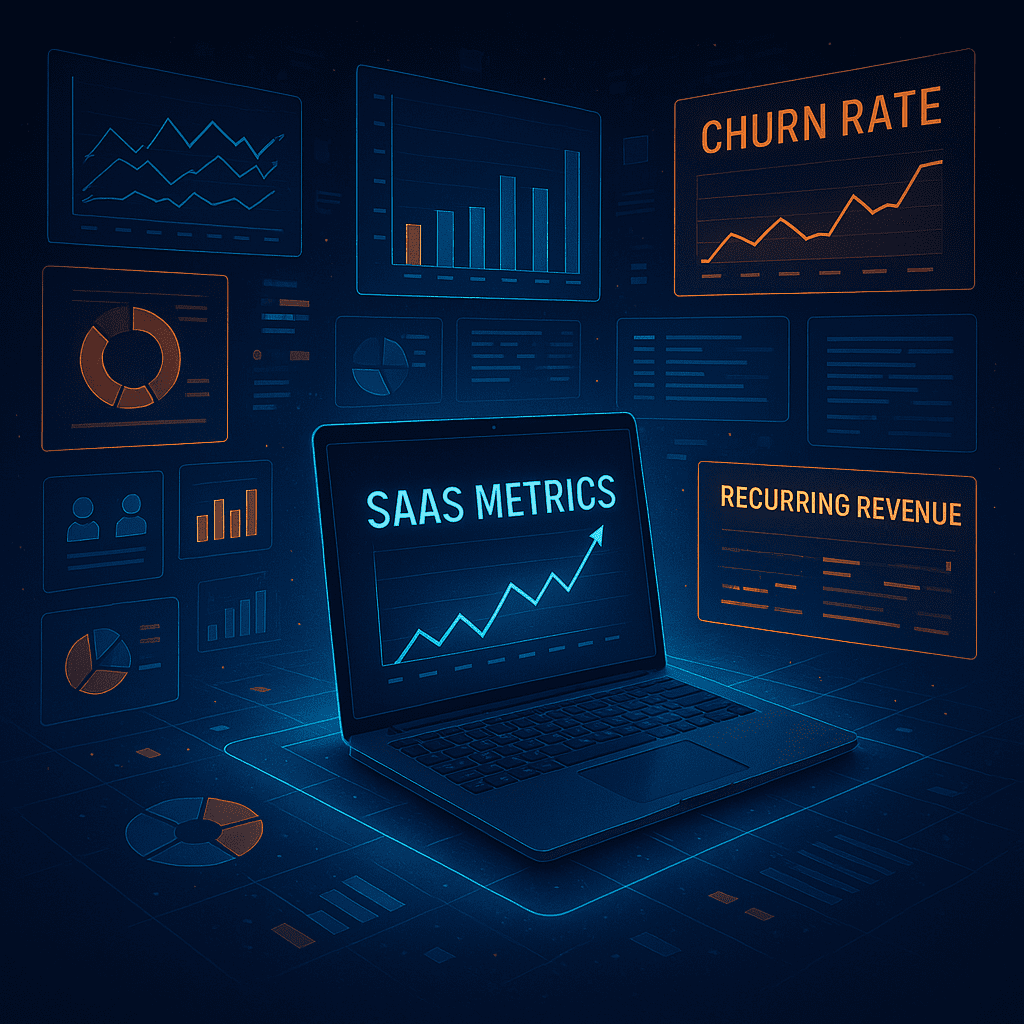A B2B SaaS company’s valuation and operational health are determined almost entirely by a core set of specialized subscription metrics. These KPIs measure the predictable, recurring revenue streams that define the SaaS business model. Unlike traditional companies that rely on one-time transactions, SaaS success is measured by metrics like the ability to acquire customers efficiently and retain them profitably over time.
Mastering these metrics is essential for forecasting growth, securing investment, and making strategic business decisions for any B2B SaaS company.
1. Recurring Revenue Metrics (The Foundation)
These metrics track the predictable income stream, which is the cornerstone of the SaaS business model.
Monthly Recurring Revenue (MRR)
MRR is the total predictable revenue a company expects to receive every month. It is the standardized, normalized monthly income from all active subscriptions.
![]()
MRR is typically broken down into four components to measure growth effectiveness:
| MRR Component | Description | Growth Impact |
| New MRR | Revenue from new customers acquired in the period. | Tracks customer acquisition efficiency. |
| Expansion MRR | Additional revenue from existing customers (upgrades, add-ons). | The most valuable growth source; tracks upsell success. |
| Churn MRR | Revenue lost from customers who canceled their subscriptions. | Tracks customer retention and product satisfaction. |
| Contraction MRR | Revenue lost from existing customers who downgraded their plans. | Tracks perceived value loss and downgrade risk. |
Annual Recurring Revenue (ARR)
ARR is the predictable recurring revenue standardized for a full year. It is the most common metric used for valuing companies with annual or multi-year contracts, especially for larger enterprises.
![]()
2. Customer Acquisition and Efficiency Metrics
These metrics quantify the cost and effectiveness of bringing new customers onto the platform.
Customer Acquisition Cost (CAC)
CAC is the total average cost spent on sales and marketing to acquire a single new paying customer. It provides a measure of how capital-efficient the company’s growth is.
![]()
- Goal: Companies aim to minimize CAC while maximizing the quality of acquired customers.
Time to Recover CAC (CAC Payback Period)
This metric measures how many months it takes for a new customer to generate enough cumulative revenue (MRR) to recoup the initial investment (CAC).
![]()
- Goal: A shorter payback period (ideally under 12 months) indicates a faster return on marketing and sales investment, accelerating cash flow and allowing the company to reinvest for growth sooner.
3. Customer Retention and Value Metrics
These metrics track how well a company retains its customer base and the total financial value generated by those customers.
Churn Rate
Churn is the percentage of customers (or revenue) lost over a given period. It is a key indicator of product-market fit and customer satisfaction.
- Customer Churn: The percentage of customers who stopped their service.
![Rendered by QuickLaTeX.com \[\text{Customer Churn Rate} = \frac{\text{Customers Lost in Period}}{\text{Customers at Start of Period}}\]](data:image/svg+xml;base64,PHN2ZyB3aWR0aD0iMSIgaGVpZ2h0PSIxIiB4bWxucz0iaHR0cDovL3d3dy53My5vcmcvMjAwMC9zdmciPjwvc3ZnPg==)
- Revenue Churn (MRR Churn): The percentage of recurring revenue lost from canceled subscriptions and downgrades.
- Goal: A lower churn rate is always better. For B2B, anything under 5% monthly is generally considered healthy, with enterprise-focused SaaS often aiming for much lower or near-zero rates.
Net Revenue Retention (NRR) / Net Dollar Retention (NDR)
NRR (or NDR) is arguably the most critical metric for evaluating the overall health of a SaaS business. It measures the change in recurring revenue from a cohort of existing customers over a period, accounting for both revenue lost from churn/contraction and revenue gained from expansion.
![]()
- Goal: An NRR above 100% (e.g., 110% to 130%) is exceptional. It means the revenue generated from existing customers’ upgrades and add-ons is greater than the revenue lost from customers who churned or downgraded. This demonstrates the company can grow even without acquiring new customers, often called “Negative Churn.”
Customer Lifetime Value (LTV)
LTV is the total expected gross revenue a single customer will generate over the entire duration of their relationship with the company.
![]()
- Goal: LTV is used primarily to calculate the LTV:CAC Ratio.
4. Financial Health Metrics
These ratios compare the efficiency of customer acquisition against the long-term value generated.
The LTV:CAC Ratio
This ratio is the definitive measure of a SaaS company’s financial health, indicating whether the cost of acquiring a customer is justified by the revenue they eventually provide.
![]()
- Benchmark: A healthy, sustainable SaaS business should aim for an LTV:CAC ratio of 3:1 or higher.
- Less than 1:1: The business is losing money on every customer.
- 1:1 to 2:1: The business is acquiring customers inefficiently and will struggle to scale.
- 4:1 or higher: Often indicates a massive opportunity for growth by increasing sales and marketing spend.
Gross Margin
Gross Margin measures the profitability of the service itself before operating expenses (like G&A, S&M, and R&D) are factored in. It is calculated as the total revenue minus the Cost of Goods Sold (COGS)—which, for SaaS, primarily includes hosting, maintenance, and customer support costs.
![]()
- Goal: A high Gross Margin (ideally 70-80% or higher) is crucial. It shows that the business model is scalable and generates significant capital to fund future R&D, sales, and marketing efforts.
Metrics as the Navigator for SaaS Growth
B2B SaaS metrics are more than just numbers; they are the financial DNA and operational compass of the business. By consistently tracking and optimizing indicators like MRR, CAC Payback Period, and the LTV:CAC Ratio, companies gain the necessary transparency to move from merely selling software to building a scalable, high-margin, and valuable asset.
Ultimately, the goal is to achieve Negative Churn (NRR > 100%) and a high Gross Margin (70%+). These signals indicate a self-sustaining engine where existing customers are your greatest source of revenue, and the fundamental service is highly profitable, ensuring that the next investment in sales, marketing, or product development will drive efficient, predictable growth. For any B2B SaaS company, mastery of these metrics is the prerequisite for long-term success and attracting premium valuation in the market.

